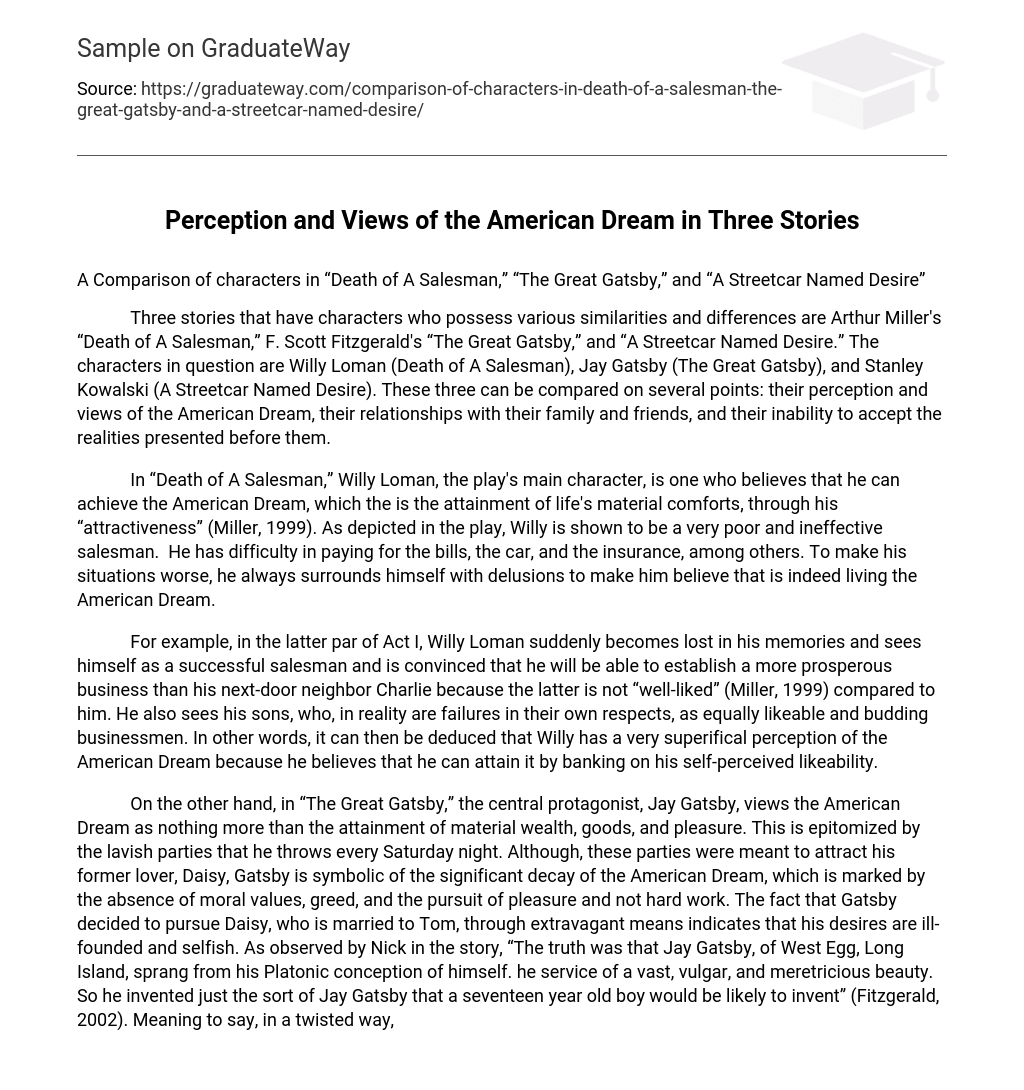A Comparison of Characters in Death of a Salesman,” “The Great Gatsby,” and “A Streetcar Named Desire”
Three stories feature characters who possess both similarities and differences: Arthur Miller’s “Death of A Salesman,” F. Scott Fitzgerald’s “The Great Gatsby,” and Tennessee Williams’ “A Streetcar Named Desire.” The characters in question are Willy Loman (Death of A Salesman), Jay Gatsby (The Great Gatsby), and Stanley Kowalski (A Streetcar Named Desire). These three can be compared on several points, including their perception and views of the American Dream, their relationships with family and friends, as well as their inability to accept the realities presented before them.
In Death of A Salesman,” Willy Loman is the main character who believes that he can achieve the American Dream, which is the attainment of life’s material comforts, through his “attractiveness” (Miller, 1999). However, as depicted in the play, Willy is shown to be a very poor and ineffective salesman. He has difficulty paying for bills, car payments, insurance and other expenses. To make matters worse, he surrounds himself with delusions to convince himself that he is indeed living the American Dream.
For example, in the latter part of Act I, Willy Loman suddenly becomes lost in his memories. He sees himself as a successful salesman and is convinced that he will be able to establish a more prosperous business than his next-door neighbor Charlie. This is because he believes that Charlie is not “well-liked” (Miller, 1999) compared to him. Willy also sees his sons as equally likeable and budding businessmen, despite their failures in their own respects. In other words, it can be deduced that Willy has a very superficial perception of the American Dream because he believes that he can attain it by banking on his self-perceived likeability.
In The Great Gatsby,” the central protagonist, Jay Gatsby, views the American Dream as nothing more than the attainment of material wealth, goods, and pleasure. This is epitomized by the lavish parties that he throws every Saturday night. Although these parties were meant to attract his former lover Daisy, Gatsby is symbolic of the significant decay of the American Dream marked by the absence of moral values, greed, and pursuit of pleasure instead of hard work. The fact that Gatsby decided to pursue Daisy who is married to Tom through extravagant means indicates that his desires are ill-founded and selfish.
As observed by Nick in the story: “The truth was that Jay Gatsby…sprang from his Platonic conception of himself…in service to a vast vulgar and meretricious beauty. So he invented just the sort of Jay Gatsby that a seventeen-year-old boy would be likely to invent” (Fitzgerald 2002). In other words, apart from material goods and wealth, Daisy is also Gatsby’s American Dream. Like Willy Loman in “Death Of A Salesman,” he too finds himself in an illusion that he can win Daisy through his massive wealth.
In contrast, Stanley Kowalski from “A Streetcar Named Desire” has a contrasting view of the American Dream. This is highlighted by his bitter hatred towards Blanche, the sister of his wife Stella. Stanley views Blanche as an obsolete survivor of an aristocracy due to her inherited family wealth. Despite being Polish by blood, Stanley believes that the only way to attain the American Dream is through hard work. This is evident in his reaction when Blanche called him a Polack: “I am not a Polack. People from Poland are Poles, not Polacks. But what I am is a one hundred percent American, born and raised in the greatest country on earth and proud as hell of it, so don’t ever call me a Polack” (Williams, 2004). In other words, Stanley fully embraces his American citizenship and therefore embraces the American Dream while rejecting the notion of inheriting wealth and being content with his average social status.
Furthermore, Willy, Gatsby, and Stanley have comparable points in terms of family relationships and their perception of reality. Among the three characters, Willy has the most strained relationship with his family. As shown in the play, he surrounds himself with false realities and rejects the love that his family gives him. He constantly berates his eldest son Biff for being a failure instead of accepting him for who he is. Additionally, he burdens his family by being delusional and refusing to face reality.
Gatsby, on the other hand, only has a close relationship with his former lover Daisy, with whom he rekindles their passion. In the context of modern society, their relationship is illegal as Daisy is married to another man. However, the larger issue here is that Daisy has become Gatsby’s obsession as shown in the lavish parties that he throws to impress her and his constant fabrication of false identities. As a result, like Willy, he fails to recognize the true essence of the American Dream and is unable to accept the reality that Daisy does not feel the same way about him.
Finally, Stanley can be viewed as having the healthiest relationship with his family among these three characters. As shown in the play, he is very passionate about his wife and loyal to his friends. However, it is revealed towards the end of the story that he only pursues earthly desires such as sex, drinking and gambling. Another major issue with him is that he possesses animal-like behavior and cannot accept Blanche’s aristocratic yet tragic past which led him to torment her.
Overall, Willy, Gatsby, and Stanley share a common struggle in acknowledging and accepting reality. However, they have vastly different interpretations of the American Dream. Willy clings to his delusions, Gatsby pursues forbidden love through wealth, and Stanley indulges in vices such as sex, gambling, and drinking.
References
Fitzgerald, F. S. (2002). The Great Gatsby. Retrieved May 25, 2009 from http://gutenberg.net.au/ebooks02/0200041.txt on The Project Gutenberg Australia website.
Miller, Arthur. (1999). Death of a Salesman. New York: Reed Business Information, Inc.
Williams, T. (2004). A Streetcar Named Desire. New York: New Directions Publishing Corporation.





